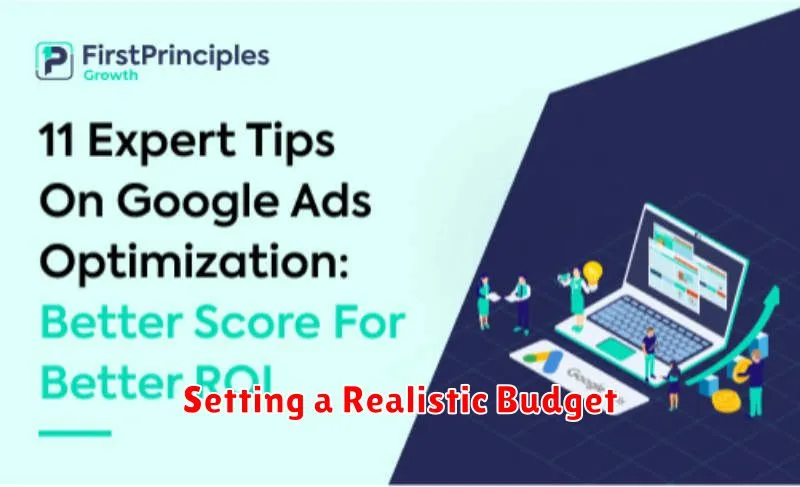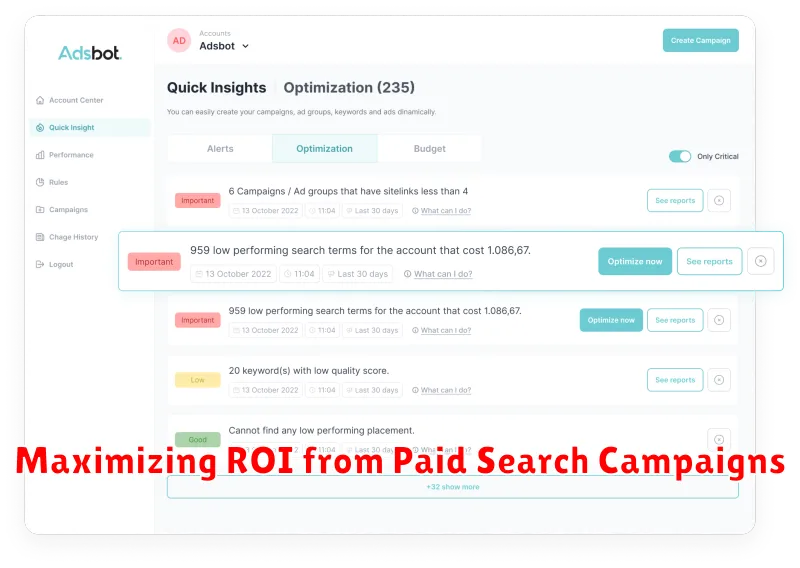Paid search campaigns are a cornerstone of modern digital marketing, offering businesses the opportunity to connect directly with their target audience at the precise moment they’re searching for relevant products or services. However, simply launching a campaign isn’t enough to guarantee success. Maximizing ROI from paid search requires a strategic approach, meticulous planning, and ongoing optimization. This article delves into the essential strategies and tactics to help you achieve a high return on investment from your paid search campaigns and unlock their full potential.
From keyword research and bid management to ad copy optimization and conversion tracking, we’ll cover the key components of a successful paid search strategy. Learn how to effectively target your ideal customers, craft compelling ad copy that drives clicks, and continuously refine your campaigns to achieve optimal performance and maximize your ROI. Whether you’re new to paid search or a seasoned marketer looking to enhance your existing campaigns, this guide provides actionable insights to help you unlock the power of paid search advertising and drive meaningful business growth.
Understanding Paid Search
Paid search, also known as pay-per-click (PPC) advertising, is a fundamental component of digital marketing. It involves businesses paying a search engine, like Google or Bing, to display their ads prominently on search engine results pages (SERPs). These ads appear when users search for specific keywords related to the business’s products or services.
The core principle of paid search is to target potential customers actively searching for what a business offers. Unlike other forms of advertising, paid search focuses on reaching individuals already demonstrating intent. This precise targeting minimizes wasted ad spend and maximizes the potential for conversions.
Bidding plays a crucial role in paid search. Advertisers bid on relevant keywords, competing with others in the same industry. The higher the bid and the better the ad’s quality score, the higher its position on the SERP. Quality score is determined by factors like ad relevance, landing page experience, and expected click-through rate.
Several ad formats exist within paid search, including text ads, shopping ads, and display ads. Text ads are simple text-based advertisements. Shopping ads feature product images, prices, and direct links to purchase. Display ads are visually rich and appear on websites within the search engine’s network.
Choosing the Right Keywords
Keyword selection is the foundation of a successful paid search campaign. Relevant keywords connect your ads with users actively searching for products or services like yours. Targeting the wrong keywords leads to wasted ad spend and a low return on investment.
Begin by brainstorming a list of terms your potential customers might use when searching for your offerings. Consider variations in phrasing and intent. For example, someone searching for “best running shoes” has a different intent than someone searching for “buy running shoes online”.
Utilize keyword research tools to expand your list and analyze search volume and competition. Identify high-volume, low-competition keywords for optimal performance. Don’t neglect long-tail keywords (longer, more specific phrases) which often convert at higher rates.
Group your keywords into tightly themed ad groups. This allows for more targeted ad copy and improved Quality Score, a crucial metric in determining ad rank and cost.
Continuously monitor and refine your keyword strategy based on performance data. Regularly review search term reports to identify new keywords and eliminate underperforming ones.
Setting a Realistic Budget

Setting a realistic budget is crucial for maximizing your return on investment (ROI) from paid search campaigns. A well-defined budget ensures you can allocate sufficient resources to reach your target audience without overspending. Begin by defining your campaign goals. Are you aiming for brand awareness, lead generation, or driving sales? Different objectives require different levels of investment.
Next, conduct thorough keyword research to understand the competitive landscape and average cost-per-click (CPC) for relevant keywords. This data will help you estimate potential costs and allocate budget effectively across different campaigns and ad groups. Consider factors like your target audience, industry, and geographical location, as these can influence CPCs.
Start with a test budget to gather initial data on campaign performance. Monitor key metrics such as click-through rate (CTR), conversion rate, and cost-per-acquisition (CPA). Analyze this data and adjust your budget accordingly. Increase spending on high-performing campaigns and reduce or pause underperforming ones. Regularly review and refine your budget based on performance and market changes to ensure optimal ROI.
Creating Effective Ad Copy
Compelling ad copy is crucial for paid search success. It’s the bridge connecting your target audience with your offering. Well-crafted copy improves click-through rates (CTR), quality scores, and ultimately, return on investment (ROI).
Focus on highlighting the unique value proposition of your product or service. Clearly address the user’s search intent and demonstrate how you solve their problem or fulfill their need. Use strong calls to action that encourage immediate engagement, such as “Shop Now,” “Learn More,” or “Get a Free Quote.”
Keywords play a vital role in ad copy relevance. Incorporate relevant keywords naturally within the headline and description lines. However, avoid keyword stuffing, which can negatively impact quality scores. Prioritize a natural and engaging reading experience.
A/B testing is essential for optimizing ad copy performance. Experiment with different headlines, descriptions, and calls to action to identify the most effective variations. Continuously analyze performance data and refine your copy based on CTR, conversion rates, and other key metrics. This iterative process ensures your ads resonate with your target audience and drive desired outcomes.
Landing Page Optimization
A crucial aspect of maximizing ROI from paid search campaigns is landing page optimization. A well-optimized landing page seamlessly connects your ad copy to the user’s search intent, leading to higher conversion rates.
Ensure your landing page message matches the ad copy. If a user clicks on an ad for “blue widgets,” they should land on a page specifically showcasing blue widgets, not general widget categories. This consistency builds trust and reduces bounce rates.
Clear calls to action (CTAs) are essential. Use concise, action-oriented language that tells the user exactly what you want them to do, whether it’s “Shop Now,” “Get a Free Quote,” or “Download Our Brochure.” Prominently display your CTAs and make them visually appealing.
Page speed is a critical factor. A slow-loading page can lead to user frustration and abandonment. Optimize images, minimize HTTP requests, and leverage browser caching to improve page load times. This not only improves user experience but also positively impacts your quality score, potentially lowering your cost-per-click.
Mobile optimization is no longer optional. A significant portion of searches are performed on mobile devices. Ensure your landing page is responsive and provides a seamless experience across different screen sizes. Test your landing page on various devices to ensure optimal functionality and usability.
Quality Score and Its Impact
Quality Score is a crucial metric in paid search advertising, significantly influencing both the cost and effectiveness of your campaigns. It represents an assessment of the relevance and quality of your keywords, ads, and landing pages. A higher Quality Score typically leads to lower costs and better ad positioning.
Search engines use Quality Score to determine how relevant and helpful your ads are to users searching for specific keywords. This relevance is assessed based on several factors, including the click-through rate (CTR) of your ads, the relevance of your keywords to your ad group, the overall quality of your landing page, and your historical ad performance.
A strong Quality Score can dramatically reduce your cost-per-click (CPC), allowing your budget to stretch further and potentially generate more clicks and conversions. Conversely, a low Quality Score can inflate your CPC, making your campaigns more expensive and less efficient.
Improving your Quality Score involves optimizing several key components. Focus on creating highly relevant and compelling ads that resonate with your target audience. Ensure your keywords are tightly themed within each ad group, and that your landing pages provide a seamless and positive user experience, directly addressing the search query and offering valuable information.
Using Ad Extensions Wisely
Ad extensions are crucial for maximizing your return on investment (ROI) from paid search campaigns. They provide additional information and interactive elements, enhancing your ad’s visibility and click-through rate (CTR). Wisely chosen and implemented ad extensions can significantly improve your quality score, leading to lower costs and better ad positioning.
Consider your campaign goals when selecting extensions. If driving calls is paramount, call extensions are essential. For driving foot traffic, location extensions are key. Sitelink extensions allow you to showcase different sections of your website, catering to diverse user needs and potentially increasing engagement.
Don’t overwhelm users with too many extensions. Focus on the most relevant ones for your target audience and campaign objectives. Regularly monitor and analyze the performance of your ad extensions. Evaluate which ones are generating the highest engagement and conversions. Remove underperforming extensions and experiment with new ones to optimize your results continually.
Monitoring and Adjusting Bids
Consistent monitoring of your paid search campaigns is crucial for maximizing ROI. Regularly review key performance indicators (KPIs) such as click-through rate (CTR), conversion rate, cost per conversion, and average position.
Analyze the data to identify keywords and ads that are performing well and those that are underperforming. For high-performing keywords, consider increasing bids to improve visibility and potentially gain more conversions. Conversely, lower bids on keywords with low CTRs or high costs per conversion to improve efficiency.
Bid adjustments should be made incrementally and tested over time. Don’t drastically change bids without careful consideration. Utilize automated bidding strategies offered by search engines, but maintain oversight to ensure alignment with your campaign objectives. Remember to factor in external factors like seasonality and competitor activity, which can influence bid performance.
Tracking Conversions
Tracking conversions is crucial for maximizing ROI from paid search campaigns. It allows you to understand which keywords, ads, and landing pages are actually driving valuable actions on your website. These actions, or conversions, could be anything from completing a purchase to filling out a contact form, signing up for a newsletter, or downloading a resource. Without conversion tracking, you’re essentially operating in the dark, unable to accurately measure the effectiveness of your campaigns.
Implementing conversion tracking involves setting up specific goals within your analytics platform (e.g., Google Analytics) and linking them to your paid search platform (e.g., Google Ads). You’ll then need to install a conversion tracking tag, a small snippet of code, on the pages of your website where conversions occur. This tag fires whenever a user completes a desired action, sending data back to your analytics platform and allowing you to attribute the conversion to the correct source.
By carefully monitoring your conversion data, you can identify high-performing keywords and ads, as well as low-performing ones. This data empowers you to optimize your bids, refine your targeting, and improve your ad copy and landing page experience to drive more conversions and ultimately, a higher ROI.
Improving Performance Over Time
Paid search campaigns aren’t set-it-and-forget-it endeavors. Continuous optimization is key to maximizing ROI. Regularly monitoring key performance indicators (KPIs) such as click-through rate (CTR), conversion rate, and cost per conversion is crucial.
A/B testing different ad copy, landing pages, and bidding strategies allows for data-driven decisions. By analyzing the performance of different variations, you can identify what resonates best with your target audience and drives the most conversions.
Leverage keyword research to identify new opportunities and refine existing targeting. Expanding your keyword list and incorporating negative keywords can improve reach and reduce wasted spend.
Bid management is another critical aspect of ongoing optimization. Adjusting bids based on performance data, time of day, or device can significantly impact your campaign’s efficiency and ROI.
Finally, staying up-to-date with industry best practices and platform updates is essential for long-term success. Search engine algorithms and advertising platforms are constantly evolving, and staying informed will help you maintain a competitive edge.

